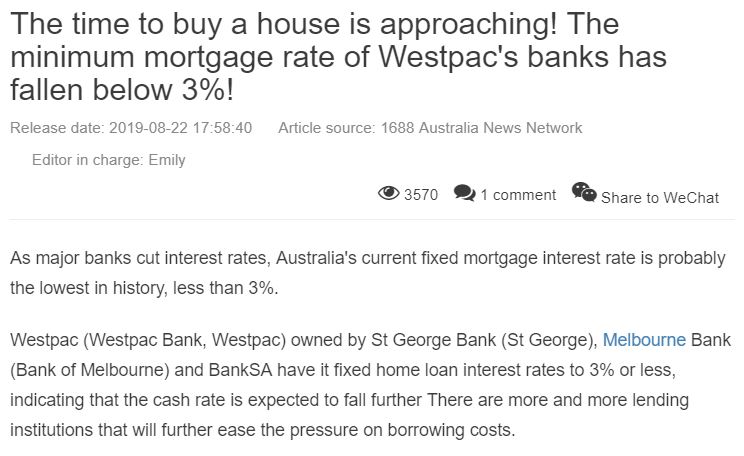
As major banks cut interest rates, Australia’s current fixed mortgage interest rate is probably the lowest in history, less than 3%. Westpac (Westpac Bank, Westpac)’s St George, Bank of Melbourne and BankSA have all cut their fixed home loan interest rates below 3%, indicating that the cash rate is expected to fall further. There are more and more lending institutions that will further ease the pressure on borrowing costs.
These changes occurred before the arrival of the crucial spring real estate sales season. Some industry experts believe that after two years of sales slump, buyers may return to the Australian real estate market this spring. St. George’s Bank and Bank of Melbourne have lowered the fixed-rate lending rate of owner-occupiers with a LTV (loan-to-value ratio) of less than 60% to 2.94%, while LTV has a loan product between 60% and 80%. Fixed interest rates have also fallen to 2.99%.
Steve Mickenbecker, a financial expert from the comparison site Canstar, said that the new interest rates offered by several Westpac banks are highly competitive and may trigger a response from competitors. He said: “The decline in bond interest rates has reduced the bank’s long-term financing costs, and several Westpac banks have already passed this effort to lenders.” RateCity research team director Sally Tindall said: “The banks compete to claim that they are Banks offering the lowest fixed interest rates on the market. Some big banks are beginning to offer lower fixed interest rates, which is generally unusual.”
She said that although the current fixed interest rate seems to be very cost-effective, the Reserve Bank of Australia may further cut interest rates, and lenders may continue to cut the variable home loan interest rate. The records of the Reserve Bank of Australia’s Board of Governors announced on August 6th show that people are increasingly worried about the impact of the escalation of US-China trade tensions on the Australian economy. Members have already explored unconventional monetary policy measures such as quantitative easing. The minutes of the meeting also showed that if there is more evidence that further interest rate cuts are needed to support economic growth, the Reserve Bank of Australia will consider continuing to cut interest rates.
